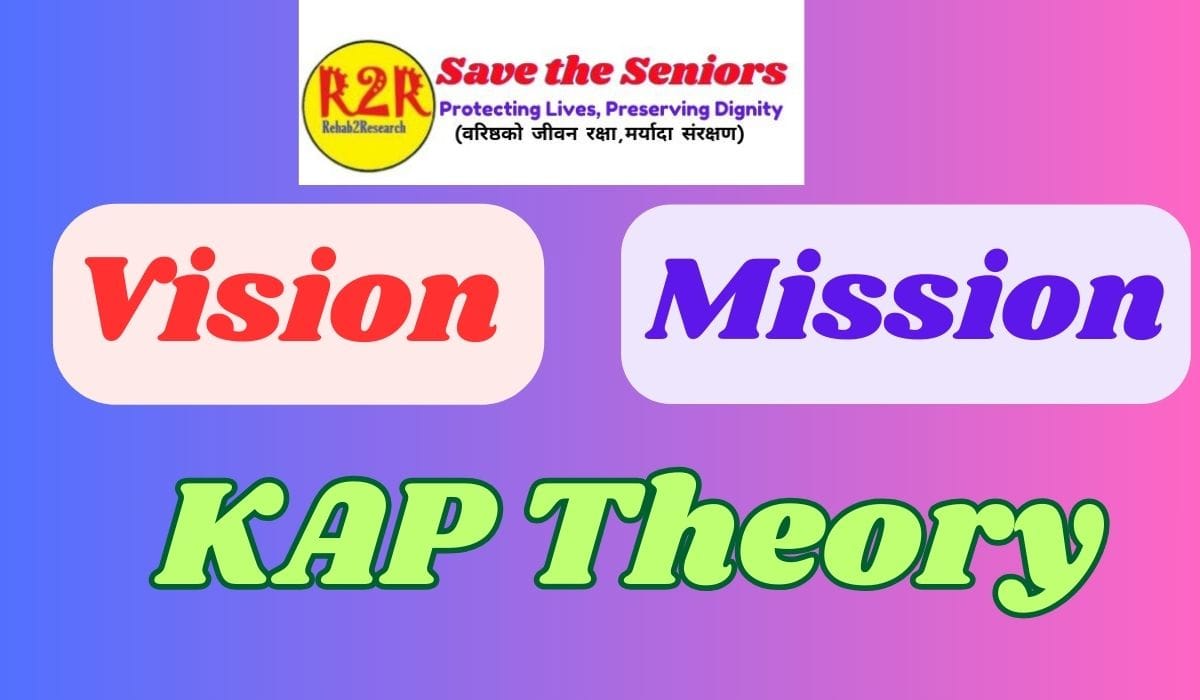Table of Contents
ToggleVision
A world where seniors live with dignity, respect, and support. (यस्तो संसार जहाँ वरिष्ठहरू मर्यादा, सम्मान र समर्थनका साथ बाँच्छन्।)
Mission
Empowering seniors through advocacy, resources, and fostering healthy, connected communities. (वकालत, स्रोतहरू, र स्वस्थ, जडित समुदायहरूको पालनपोषण मार्फत वरिष्ठहरूलाई सशक्तिकरण।)
Key Elements of KAP Theory
The KAP Theory of Development refers to the Knowledge, Attitudes, and Practices model, which is widely used in social and behavioral science to understand and influence development. It focuses on three interconnected factors that determine people’s behaviors and decisions in a community or society.
Knowledge (K):
- Refers to the information and awareness individuals have regarding specific issues or topics.
- In development, this can include knowledge about health, education, rights, agriculture, technology, etc.
- The assumption is that if people have accurate and sufficient knowledge, they are more likely to make informed decisions and engage in positive behaviors.
Attitudes (A):
- The personal beliefs, feelings, and perceptions individuals hold towards certain issues or practices.
- This is shaped by cultural norms, experiences, and the societal environment.
- Positive attitudes towards a behavior are crucial for people to adopt new practices and be open to change. Negative attitudes can hinder development efforts, even if the knowledge is available.
Practices (P):
- Refers to the actual behaviors or actions that individuals engage in.
- The ultimate goal of development efforts is to encourage the adoption of new or improved practices.
- Practices reflect the application of knowledge and the influence of attitudes in real life.
Application in Development:
- Understanding the gap between knowledge, attitude, and practice helps development workers identify why certain beneficial practices are not being adopted despite awareness.
- Behavior Change Communication (BCC) often uses KAP studies to design targeted interventions. By measuring the levels of knowledge, attitudes, and practices, organizations can create strategies to address gaps and facilitate change.
- Evaluation: KAP surveys are frequently used as a tool to assess the effectiveness of development programs, ensuring that knowledge transfer translates into actual behavioral change.
Challenges in KAP-based Development:
- Disconnection between knowledge and practice: People may know, but cultural beliefs or lack of resources can prevent them from adopting the new practices.
- Attitude change: Shifting attitudes is often more difficult than providing information, as it involves deep-rooted beliefs and societal norms.
The KAP theory is valuable in understanding human behavior in the context of development, as it helps to create interventions that are tailored to address the specific factors influencing people’s decisions and actions.
Conclusion
The vision and mission of “Save the Seniors” reflect a heartfelt commitment to improving the lives of aging populations. By advocating for their rights, promoting dignity, and fostering community support, the organization strives to create a world where seniors are valued, respected, and empowered. Guided by these principles, “Save the Seniors” is dedicated to making a lasting impact and ensuring a brighter future for older generations. Read more



